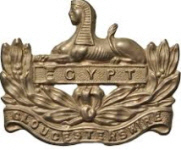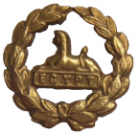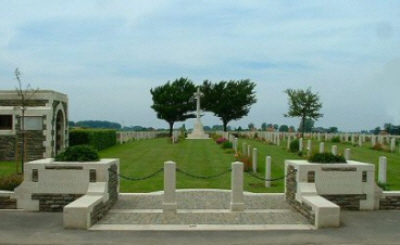




24189, Lance Corporal, Bertram Stanley CROOK
Aged 20

|
Born in Shepton Mallett in Q3-1895 [Shepton Mallett 5c:451], 3rd son of William and Elizabeth CROOK (neée HALL) of 15 Town Street, Shepton Mallett.
1901 census...Bertram [5] was at 17 Lower Lane, Shepton Mallett with his father William [34],a gardener; his mother Elizabeth [35]; brothers Walter [11]; Percival [6] and Gordon [1] and sisters Ethel Rose [8] and Beatrice May [3]. The whole family were born in Shepton Mallett. 1911 census...Bertram was now a stableman at Stanley House Stables (Joseph Cannon) Bury Road Newmarket. The rest of his family were still at the same house in Shepton Mallett, now with added siblings, Gladys Victoria [10]; William Frederick [8]; Elsie May [6]; Winifred Jesse [5]; Ivy Elizabeth [3] and Leslie Septimus [1]. One child had died. |

|
The Gloucestershire Regiment is unique in the British Army in that they wear a badge front and back on their headdress, a honour bestowed on them in 1801 after fighting
in Alexandria, Egypt when fighting back to back when surrounded. The Gloucester's Bantams went to France on 30th January 1916, and were in the trenches first at Festubert and Givenchy and later at Laventie. as with all Bantam Battalions, their first task on going into the trenches was to raise the height of the firing step. In 1914 the Member of Parliament for Birkenhead, Alfred Bigland, pressed the War Office for permission to form a battalion of men who were under regulation size but otherwise fit for service. A few days later, some 3,000 men had volunteered, many of whom had previously been rejected as being under height. The original men were formed into the 1st and 2nd Birkenhead Battalions of the Cheshire Regiment (later redesignated the 15th and 16th Bns). Other regiments began to recruit similarly: the Lancashire Fusiliers, West Yorkshires, Royal Scots, and Highland Light Infantry most notably. Many of the recruits were miners. Eventually these units were formed into the 35th Division. Another Division, the 40th, had a mixture of bantam and regulation units, although it is generally recognised as a bantam formation. The bantams were very popular at home and were often featured in the press. However, by the end of 1916, it was found that the general fitness and condition of men volunteering as bantams was no longer up to the standard required. Brigades were informed that no more undersized men would be accepted, and the Divisions lost their bantam status as replacements diluted the number of small men in the mix. The 14th Gloucesters only had 3 men killed in over a week, indicating a spell of inactivity interspersed with some artillery and sniper fire. |

photo: Michael J. Pettitt

© www.peterswar.net
click here to go to the Commonwealth War Graves Commission website for full cemetery/memorial details